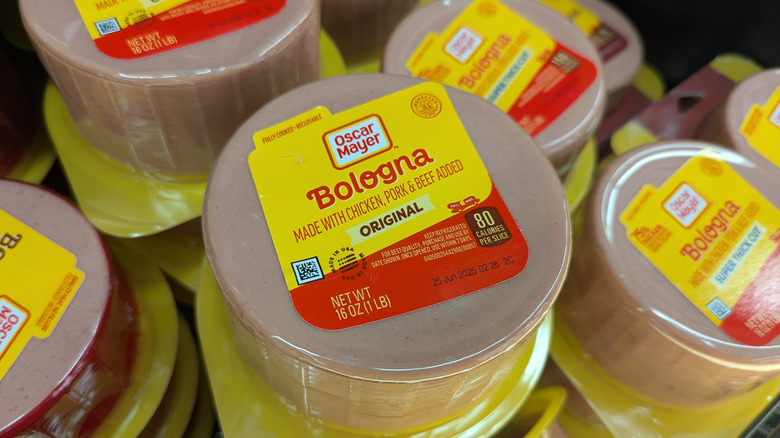The One Bologna Myth That Will Never Die
You either love bologna or you hate it. There's zero room for indifference — the line is drawn and everyone knows where they stand. Much of the hubbub surrounding bologna is the common and unfounded belief that it's nothing more than mystery meat. The truth is, bologna isn't some terrifying meat cobbled together from leftovers. So, if you were worried about that, take a sigh of relief – bologna is a meat that can be divided into recognizable parts.
In fact, if you flip over the package and actually look at the ingredient list, you'll see that bologna is surprisingly straightforward. We're talking about real meat — beef, pork, chicken, or turkey — plus a handful of seasonings, water, and curing agents. Not so mysterious, right? If you stick with reputable brands, the ingredients are usually pretty basic and easy to understand. I can relate to the apprehension though; I can't tell you the number of horror stories I heard as a kid regarding my beloved fried bologna sandwiches. We're talking ground-up eyes, ears, and whatever other scraps no one wanted. But, thankfully, none of that is true.
What's really in your bologna
There are some high-quality bologna brands that add corn syrup to create a smooth texture and flavor, and most include sodium nitrite to preserve freshness and that iconic pink color; that's about it as far as "mystery" is concerned. While it's still processed meat, bologna is far from the grab-bag of scraps people often imagine.
The USDA has clear regulations about what can go into bologna. It has to be made from real meat, and even the lower-tier options have to list exactly what's in there. If it says "mechanically separated chicken" or "beef," that's what's been used — it's not a code for unidentifiable animal parts. These terms might sound off-putting, but they refer to actual processes used to extract meat from bones or trim, not mystery substances.
There's also a wide range in quality. Some store brands do use more fillers and flavor enhancers, which can contribute to the processed-food reputation. But when you look at higher-end bologna, the difference is clear: recognizable cuts of meat, fewer preservatives, and no artificial colors or flavors. That's a long way from the cartoon version of bologna we've all heard about. And let's not forget that bologna itself is a cousin of mortadella, an Italian cold cut that's often considered more sophisticated, even though it shares many of the same ingredients and preparation methods.
It's really about perception. Bologna isn't hiding anything from you — it just got a bad reputation somewhere along the way, and the myth stuck. Bologna can be used for breakfast sandwiches, as a quick mid-day snack fried up for kids (or adults), or can be diced and added to salad, spaghetti, and rice dishes. It's pretty versatile and has a great flavor to work with, so it's definitely worth reconsidering.

